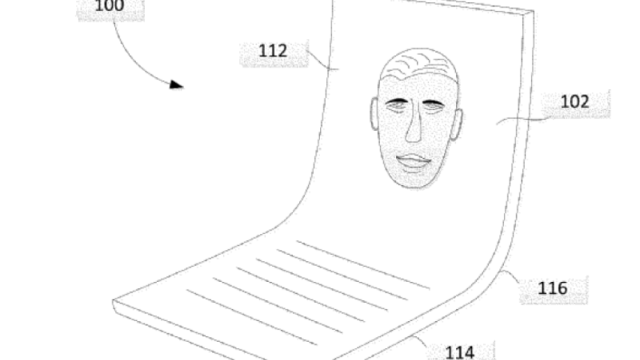Everyone wants a piece of the emerging folding phone market, and unsurprisingly the Powers That G are also getting on the bendy bandwagon.
A patent spotted by PatentlyMobile describes a folding “computing device” (we’re going to assume that means phone) that’s thin and can be folded many times without developing creases.
Google explains the problem with current smartphones:
“Modern computing devices often attempt to achieve a balance between portability and functionality.
A tension can exist between having a display that provides for a rich display of information on a single surface, which suggests a relatively large form factor of the device to accommodate a relatively large display, and a device that is small enough to be easily carried and accessed by a user, which suggests a relatively small form factor of the device.”
In other words, you want a big phone when you’re using it and a small phone when you’re not.
Google goes on to describe some of the problems with other folding phone designs:
“A potential solution to address this dilemma is to use a foldable flexible display in the computing device, so that in the display’s folded configuration, the computing device has a relatively small form factor, and in the display’s unfolded configuration, the computing device can have a relatively large display.
To keep the form factor of the computing device small and slim, it is desirable to have relatively thin displays.
However, folding a relatively thin display can result in small radius bends at the fold in the display, which may be detrimental to sensitive components of the display […] In addition, thin displays can be relatively fragile and in need of protection against breakage from impacts to the front surface of the device.”
As we suspected, it sounds like other folding phone designs are going to be pretty fragile – plus we’ve already heard about creases in the Galaxy Fold’s screen.
Google’s solution is fairly technical and mainly focuses around how the display will be made – the various layers it’ll need and how the company will keep it sufficiently thin and bendy.
However, the patent drawings give us a good idea of what they’re envisioning: instead of a book-fold like the Galaxy Fold or a Z-fold like the Huawei Mate X, Google’s design seems to be more of a wallet fold – a rectangular device that folds in on itself once. Like Ross Geller’s hand:
It looks kind of similar to the gorgeous mechanical hinge on the Microsoft Surface Book, but one of the criticisms of that design was the gap between the two halves of the laptop. This phone would have the same problem – again, like Ross Geller’s hand.
The gap isn’t necessarily a technical or functional issue, but it bothers some people visually, and of course the phone won’t fit as easily into a pocket as it would if it folded completely flat.
As ever with patents, this design may never come to fruition and it might not be intended as a marketable smartphone at all. Often, the designs are just illustrations of the particular mechanism or function that the company is patenting. So we wouldn’t expect to see a wallet-like Pixel foldable anytime soon, but it’s interesting to see what the Big G is working on behind the scenes.
